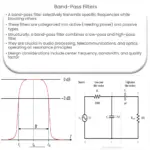Explore the workings of Electromagnetic Wave Filters, their key principles, types, and crucial role in modern communication systems.
Understanding Electromagnetic Wave Filters
Electromagnetic wave filters, also known as radio frequency (RF) filters, are crucial components in a plethora of electronic devices, from radios to smartphones. Their primary function is to selectively allow certain frequencies of the electromagnetic spectrum to pass while blocking others. This is crucial for efficient communication and signal processing.
Principles of Operation
RF filters operate based on the principles of resonance and impedance. A resonant circuit or device vibrates most freely at a particular frequency, known as its resonant frequency. In RF filters, this principle is applied to create a ‘passband’ where the filter has the least resistance (or impedance).
- Low-pass filters: These filters allow frequencies below a certain cutoff frequency to pass through while attenuating higher frequencies.
- High-pass filters: These work in the opposite way, allowing higher frequencies to pass through while blocking lower frequencies.
- Band-pass filters: These filters allow a certain range of frequencies to pass through, blocking frequencies below and above this range.
- Band-stop filters: Also known as notch filters, these block a specific range of frequencies while allowing frequencies below and above this range to pass through.
Importance in Communication Systems
RF filters play a vital role in modern communication systems. They prevent interference between different radio channels and eliminate unwanted noise or signals. This is especially important in densely populated areas where multiple devices are transmitting and receiving signals simultaneously. Without RF filters, the signals would interfere with each other, leading to degraded signal quality and potential communication failures.
Conclusion
In summary, RF filters, through their ability to control the passage of specific frequencies, contribute significantly to the efficient operation of our modern electronic devices. They serve as the ‘gatekeepers’ of the electromagnetic spectrum, ensuring that only the desired frequencies reach our devices while unwanted signals are blocked1.
1: It is important to note that while this article provides a high-level overview, the actual design and operation of RF filters can be quite complex, involving detailed electronic theory and advanced mathematical concepts.



